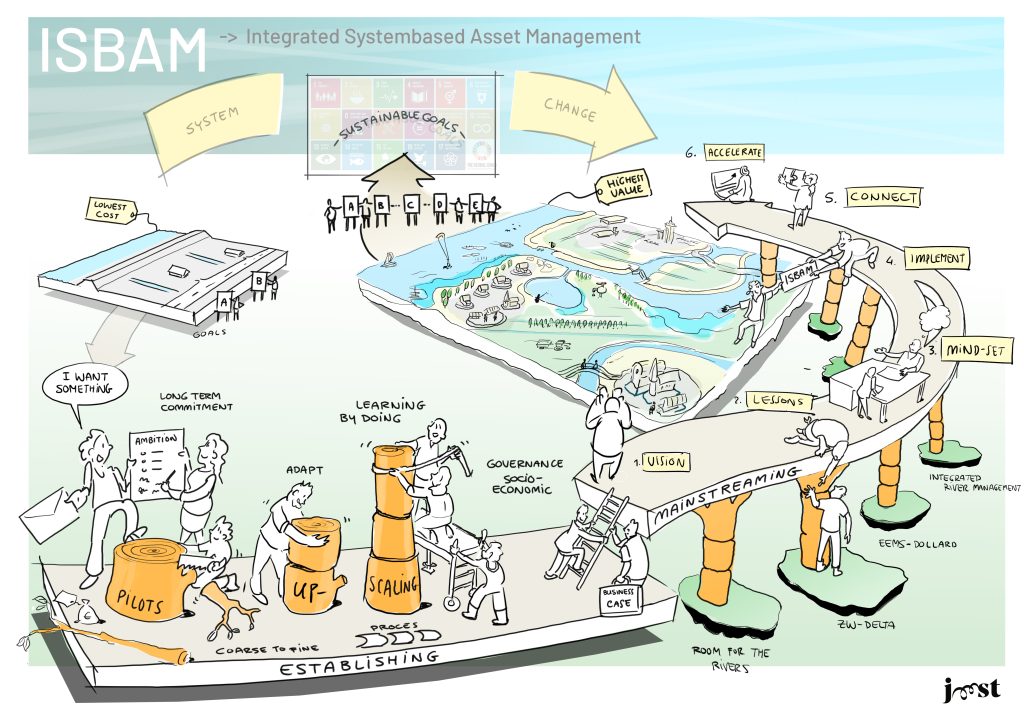Integrated System-based Asset Management (ISBAM)
In 2020 Rijkswaterstaat and EcoShape defined the first concept of Integrated System-based Asset Management (ISBAM), as a key approach to transition to sustainable and resilient water infrastructure from an asset management perspective and, consequently, to mainstream Nature-based Solutions. In 2021 this concept was developed in a first paper, which described the barriers and enablers of ISBAM, discovered through interviews with key stakeholders. This paper also provided three recommendations to achieve mainstreaming of ISBAM.
The content and recommendations of this paper were discussed in a webinar co-hosted by Rijkswaterstaat and EcoShape in July 2021. These activities resulted in increasing support for the ISBAM concept, which resulted in the 2022 paper with focus on:
- Advancing the ISBAM concept, providing a vision and roadmap for upscaling and mainstreaming, in line with the first recommendation of the 2021 paper;
- Discussing the concept with key stakeholders and increase the support for it, in the Netherlands and internationally.
This page provides further background and the links to the 2021 and 2022 papers and the 2021 webinar.
Download White Papers
ISBAM 1: The Business Case for scaling-up Building with Nature in the Netherlands
Building with Nature (BwN) is an approach that makes active use of natural forces and processes to develop, implement and upscale Nature-Based Solutions (NBS) for water-related challenges and infrastructural needs. NBS involve a combination of green and grey solutions. In addition to the primary function they fulfill for infrastructural purposes specifically, they maximize the combined benefits for society and ecology.
Mainstreaming BwN and NBS is essential to climate adaptation. This was concluded at the Climate Adaptation Summit at the beginning of 2021. Water is the main challenge for climate adaptation and through the approach of BwN, implementing NBS can achieve resilience and sustainability for ecosystems and communities. Despite many developments in the field, mainstreaming these concepts is still proving to be difficult.
This paper advises the adoption of Integrated System-based Asset Management to mainstream BwN projects in the Netherlands. The authors hope the findings and the recommendations presented here will motivate water managers to embed a system-based vision with BwN at its centre in water policy.
Link to Webinar
ISBAM 2: A methodology for sustainable nature-based water management
We are pleased to share our newly published paper “Integrated System-based Asset Management (ISBAM) 2: a methodology for sustainable nature-based water management.” This paper follows the paper and webinar held last year to introduce ISBAM as a new way of working, which improves the business case for scaling up Building with Nature in the Netherlands.
This paper presents an approach to achieve ISBAM as a standard methodology in water management, which is applicable world-wide when adapted to the local governance context. This methodology includes two intersecting pathways: establishing ISBAM at a program level and mainstreaming ISBAM across programs. In line with the previous paper, this approach follows the EcoShape six enablers. Of those technical, adaptive monitoring and management, multi-stakeholder and business case likely predominant in the establishing trajectory at program level. Capacity building and, potentially, institutional embedding prevail at mainstreaming pathway.

